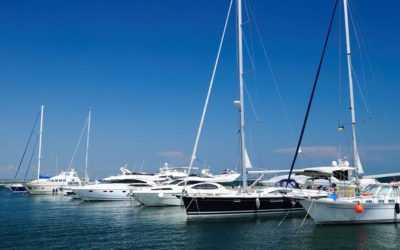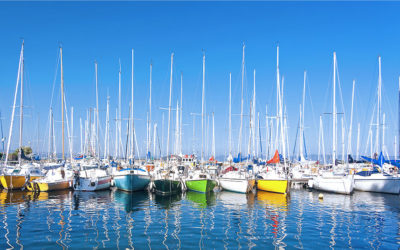Your boat is your companion when you head out to sea, but your best friend for discovering magical places is the dinghy! A dinghy is a must-have when you’re sailing. You may not realise it, but a boat’s dinghy is used as often as the boat itself, and sometimes even more! It is necessary to take the time to think about how to choose and maintain the dinghy of your boat, new or used!
1. How to choose the right dinghy ?
The dinghy is a small additional boat, specific to your boat and your needs. In order to choose the right dinghy for your boat, it is important to take into consideration various elements, because of the variety of dinghies available on the market. In addition to its function as a transport vessel to land, it can also be used for other activities such as fishing or diving.
Begin by identifying your needs. These requirements will guide you in choosing the right tender for your boat.
- How many people are expected to be on board, to determine the size and stability required
- The frequency of use for the choice of materials and the quality required
- The water sports activities practised, to measure the space required and take into account the equipment carried and the minimum essential storage
Determine the required size of the dinghy
Before investing, use a tape measure and measure exactly how much space is available to store it, whether on davits, the deckhouse, or the well deck. Never forget that the storage capacity defines the size of the dinghy. As a general rule, a 2.50-m dinghy is sufficient for a boat of less than 12 metres, but for a monohull of more than 12 metres, it can be around 3.5 m long. For a catamaran or trawler at least 15 metres long, you can have a comfortably-sized dinghy.
2.What to remember before buying a dinghy
Points to keep in mind to help you make the right choice when buying your dinghy:
The material of the inflatable floats
There are two possible fabrics for the inflatable floats: PVC or Hypalon. PVC has the advantage of being inexpensive, but it has poor resistance to UV. Hypalon is the converse: more expensive but with low sensitivity to UV. PVC is good value for money, but it is preferable to choose Hypalon. See our article on this topic: Inflatable: PVC or Hypalon?
How to choose the right floor for your boat dinghy
The floor of your boat dinghy can be made of slats, an inflatable floor or a rigid floor. You can also find wooden or alloy floors, but these are less common. Your choice should be based on your expectations on board.
- The slat floor for occasional use: a light, compact dinghy will allow you to move quickly and easily on the water.
- The inflatable floor for regular use: a dinghy with great stability on the sea and a minimum bulk for storage.
- The rigid base for intensive use: a dinghy with remarkable performance on the water which will make you forget its massive size when it comes time to store it.
Motorisation of your boat tender
How your dinghy is powered is another important factor. Above all, do not exceed the maximum recommended power, because this could damage your vessel. Most dinghies are around 3 metres long and have a 3 to 5 HP engine.
Once your dinghy is on board, make sure to comply with safety rules. For short outings in fair weather, your boat can tow the dinghy, but this should only happen very occasionally, because the weather is unpredictable.
For long distances or a brisk wind, your dinghy must be firmly attached upside down to the bridge or hung from the davits. And for long voyages or in bad weather, it should be deflated and stowed on board. For large vessels equipped with a garage, the question does not even arise.
3.What are the different types of dinghy ?
There are many rigid, semi-rigid and inflatable dinghies on the market, and it can be difficult to make the right choice. Furthermore, you need to consider your boat model, your sailing programme and your budget! Your boat’s tender will have to be strong enough to stay on the beach, to withstand an unfortunate encounter with a rocky area or to hang for hours in the sun. Dinghy ranges go from small, lightweight inflatable dinghies to the most sophisticated, motorised boats. Band of Boats presents a comparative selection of the most representative tenders on the market.
Inflatable kayak:
For a small boat with a small crew (1 or 2 people), the inflatable kayak is the low-cost solution. It is manoeuvrable, fast, and takes up little space on board. The kayak is equipped with solid paddles, and lets you observe marine wildlife without scaring it. The main drawback remains its low payload capacity, which makes a difference when bringing large quantities of provisions on board.
Rigid dinghy:
This is an occasional dinghy, mainly used to return to your boat at its mooring. It can have whee at the stern for easy launching and transportation from the beach.
Inflatable dinghy with slatted floor :
This is a lightweight dinghy that is easy for one person to transport. When rolled up, it is easy to stow in a locker. Its flat bottom is not favourable in choppy waters, but it provides stability. This dinghy should be ruled out for use on a cruise, because it is fragile and has limited marine performance.
Inflatable dinghy with inflatable floor :
This is as compact as the dinghy with slatted floor. Thanks to its V-shaped inflatable bottom, it rides well through choppy waters and has good manoeuvrability. This dinghy is a little more expensive and requires more time to launch, but its performance is impressive.
Inflatable dinghy with aluminium floor :
More stable and with better performance than its comrades, this dinghy nevertheless requires significant storage space. It is ideal if you are looking for a hard floor that can withstand transporting heavy equipment. It is stowed upside down on the bridge or on davits.
Semi-rigid dinghy :
This dinghy has the best handling properties and the most secure feel thanks to its polyester (or aluminium) hull bottom. It is also the most expensive one. It is generally stowed on davits because of its size, or in a dinghy garage in the case of bigger boats.

